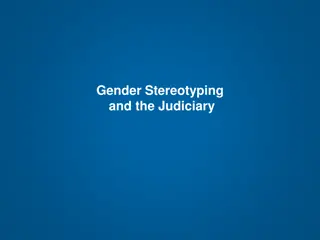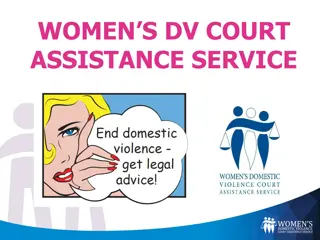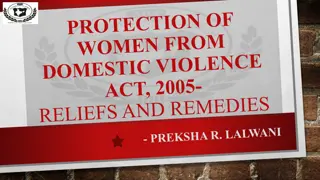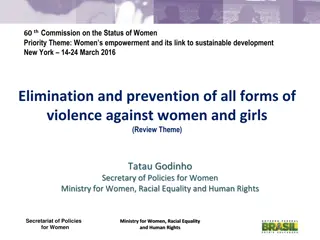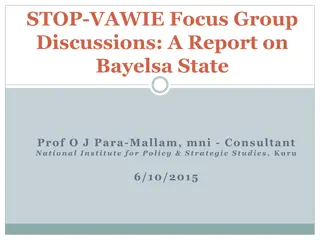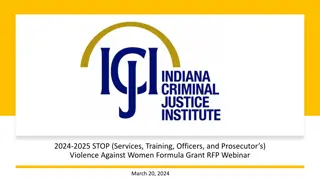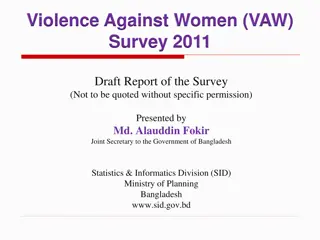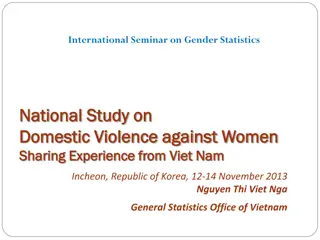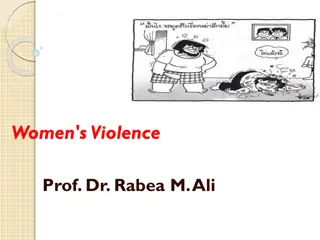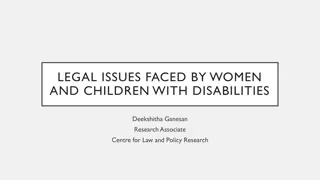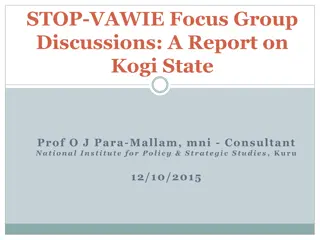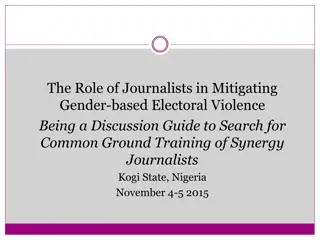Violence Against Women with Disability: Theoretical and Legal Barriers
Troubling the assumed dis/connections between gender, disability, the human, law, violence, and feminism. Examining epistemological, material, legal, political, and ontological limitations in addressing violence against women with disability. Discusses the prevalence, forms, and implications of violence, including lawful medical violence, targeting women with disabilities.
Download Presentation

Please find below an Image/Link to download the presentation.
The content on the website is provided AS IS for your information and personal use only. It may not be sold, licensed, or shared on other websites without obtaining consent from the author. Download presentation by click this link. If you encounter any issues during the download, it is possible that the publisher has removed the file from their server.
E N D
Presentation Transcript
Human Rights and Violence Against Women with Disability Theoretical and Legal Barriers Dr Linda Steele, School of Law, University of Wollongong, Australia
Troubling the assumed dis/connections between gender, disability, the human, law, violence and feminism - What are the epistemological, material, legal, political and ontological limitations inherent in the categories of gendered violence and women (and even violence ) vis-a-vis violence against women with disability? - Are women fundamentally able? Are women with disability women ? - Where do women with disability sit in relation to the human and the human community ? - Can disabled women ever be subjected to gendered violence , or to violence per se? - Does violence (including lethal violence) against women with disability count ? - What other groups of women might also be excluded from categories of women , gendered violence and violence ? www.facebook.com/DestroyTheJoint/ Katie Ellis. 2015. Destroy the Joint, Sure, But Feminism Must Include Disability Politics The Conversation, 24 November. Accessed 5 January 2016. http://theconversation.com/destroy-the-joint-sure-but-feminism-must- include-disability-politics-51119 2
Violence against women with disability - - Higher incidence than men with disability Higher incidence than women (and men) without disability Higher attrition rates Multiple forms: - physical, sexual, psychological and economic violence and abuse, harassment (unlawful violence) - institutional violence, chemical restraint, forced or coerced sterilisation - forced contraception, forced or coerced psychiatric interventions, forced abortion, medical exploitation, withholding of or forced medication - violations of privacy - forced isolation, seclusion and restraint - deprivation of liberty - denial of provision of essential care Leanne Dowse, Karen Soldatic, Aminath Didi, and Georgia Van Toorn. 2013. Stop the Violence: Addressing Violence Against Women and Girls with Disabilities in Australia. Background Article. Hobart: Women with Disabilities Australia. - - Stephanie Ortoleva, and Hope Lewis. 2012. Forgotten Sisters - A Report on Violence Against Women with Disabilities: An Overview of its Nature, Scope, Causes and Consequences. Northeastern Public Law and Theory Faculty Research Paper Series No. 104-2012. 3
Lawful medical violence against women with disability Medical interventions committed exclusively or disproportionately on persons with disability without their consent ( non-consensual medical interventions ) including sterilisation, involuntary mental health treatment, involuntary detention in mental health facilities, forms of chemical restraint such as the use of mood stabilisers and psychotropic drugs in institutional residential settings such as aged care facilities and group homes. Applicable exclusively to people with disability by reason of (a) act on the disability, (b) only comprehensible for women with disability, and (c) legal frameworks apply exclusively to people with disability on basis of incapacity. Not prohibited by law explicitly permitted. 4
References on disability- specific lawful violence Linda Steele, Court-Authorised Sterilisation and Human Rights: Inequality, Discrimination and Violence Against Women and Girls with Disability? (2016) 39(3) UNSW Law Journal pp 1002-1037 Linda Steele, Disability, Abnormality and Criminal Law: Sterilisation as Lawful and Good Violence (2014) 23(3) Griffith Law Review pp 467-497 Linda Steele and Leanne Dowse, Gender, Disability Rights and Violence Against Medical Bodies 31(88) Australian Feminist Studies 117-124 (DOI: 10.1080/08164649.2016.1224081) 5
Politicising disability disability is not fundamentally a question of medicine or health, nor is it just an issue of sensitivity and compassion; rather, it is a question of politics and power(lessness). Richard Devlin and Dianne Pothier, Introduction: Toward a Critical Theory of Dis-Citizenship in Dianne Pothier and Richard Devlin (eds), Critical Disability Theory: Essays in Philosophy, Politics, Policy, and Law (UBC Press, 2006) 1, 2. - Contest medical model disability is socially constructed abnormality - Disability, imperialism and settler colonialism - Disability and biopolitics (and necropolitics) - Disability, affect and ungrievability 6
Laws monopoly on violence Law defines violence as im/permissible (criminal law offences, civil law causes of action, victims compensation, restraining orders, child welfare law) In/capacity is a basis for differential legal understandings of what constitutes violence (substituted decision making, doctrine of necessity in emergencies , lawful authority) Incapacity enables inequality and discrimination and a lower threshold for unlawful violence in relation to the incapable Lawful medical violence inextricably linked to foundational legal ordering of in/capacity
United Nations Convention on the Rights of People with Disabilities (2008) Redefines disability as an evolving, socially contingent concept (Preamble (e)). Emphasises non-discrimination and equality, both as a right in itself (Art 5; see also Art 8.1(b)) and a general principle governing its operation as a whole (Art 3(b)). Recognises the significance of intersectionality (preamble para (p)), including the intersection of gender and disability, recognising the multiple forms of discrimination experienced by women with disability (Art 6.2) and their greater risk of violence (Paragraph (q) of the preamble). Recognises the importance of individual autonomy and independence including the freedom to make choices (preamble para(n); see also Art 3(a)) Requires that persons with disabilities enjoy legal capacity on an equal basis with others in all aspects of life Article 12.1 and 12.2). Ultimately, incapacity no reason for a lower threshold for lawful violence 8 Document title
Law reform? Senate Community Affairs References Committee, Inquiry into violence, abuse and neglect against people with disability in institutional and residential settings (2015) Senate Community Affairs References Committee, Inquiry into the Involuntary or Coerced Sterilisation of People with Disabilities in Australia (2013) Ontario s current law reform review of legal capacity? 9
New directions for feminist engagement with violence against women ? Engage politically with disability Move beyond existing legal arrangements of un/lawful violence Contest foundational legal ordering of in/capacity Engage with bioethics, medicine and law, and the intersections of neoliberalism, health industries and law Transitional justice Legal education 10
Thank you! Please get in touch if you have any questions or reflections! Email: lsteele@uow.edu.au Web: http://lha.uow.edu.au/law/contacts/UOW145286.html and https://uow.academia.edu/LindaSteele


